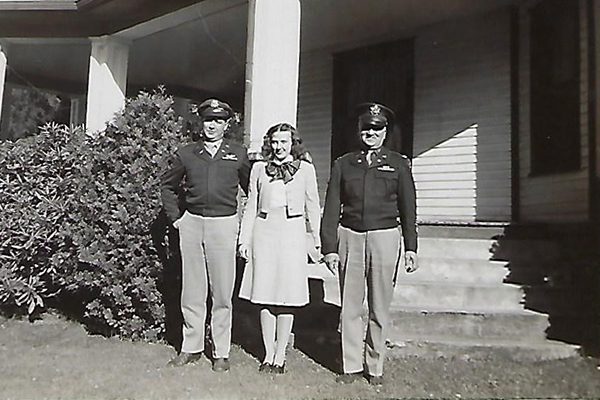James Marshall Buck

“Most of my knowledge of my grandfather’s experience comes from stories heard through the years and asking questions about memorabilia kept in a glass table at my aunt’s home. Among the items were a model of the Princess Pat (his B-24, named after my grandmother, Patricia), a photo of him and his crew, and a handkerchief of my grandmother’s that he kept in his bomber jacket for each mission, his good luck charm. My father has all of my grandfather’s old flight records, including copies of missions flown and the actual flight maps.”
– Laura Buck Sharpe, Development Project Director, University Advancement
James Marshall Buck (grandfather) and Charles F. Buck (great-grandfather), remembered by Laura Sharpe
A father and son, one serving in Belgium and the other in Italy, became wounded and reported missing, respectively, the same week.

My great-grandfather, Lt. Col. Charles F. Buck, served with the 63rd Transportation Regulation Group, which was part of the 9th Traffic Regulation Group during 1944 and 1945. This group regulated all railroad traffic to get supplies to the front lines. One of his stories was that a group of soldiers barged into his office armed with machine guns and apologized for bothering him but saying they were taking the fuel train. They were part of Patton’s 3rd Army, “requisitioning” supplies for the 3rd Army advance. During the Battle of the Bulge, he was stationed in Liege, Belgium, when a V-1 bomb landed across the street destroying the buildings, including the one he was in. The story is that he almost lost his leg but refused to let them amputate it. He was awarded the Purple Heart. His records were destroyed in a fire back in 1970 so we have no real record of his units. He was the Quartermaster Sergeant for the D.C. National Guard from 1919 until 1940. In 1940, he was advanced in rank to Captain and finally to Lt. Col. by 1944.
My grandfather, Lt. Col. James M. Buck, was put into the National Guard by his dad (Lt. Col. Charles Buck) in 1938 at the age of 15. My great-grandfather changed the record of my grandfather’s birth to 1920 to make the age “correct;” my grandfather was actually born in 1923. He served for two years until the guard was nationalized in 1940. At that time, my great-grandfather corrected the record, and my grandfather was released from service.
After Pearl Harbor my grandfather signed up for the Army Air Corps and was inducted in April 1942 as a flight cadet. In December 1942, he received his wings and became a lieutenant. Because of his ability, he was assigned as an instructor at a twin engine training base in New Mexico until the summer of 1944. He became a B-24 bomber pilot and was sent to the 15th Air Force, 450th bomb group, 723rd Squadron, based in Manduria, Italy, in September 1944. He was credited with 52 missions flown, although he actually flew 35; some missions were very long distance and the crews received credit for two missions. Overall he lost five planes, but he was not in all of them at the time. One he was on crashed at an Italian town on the Adriatic called Ravenna. He landed with wheels up and after sliding, the plane broke in half. The unhurt crew were able to step from the fuselage directly to the ground. The field he crashed in was actually a British fighter base. After the crash, his crew was put up in a hotel in town until the Air Corps could come get them. At midnight on January 1, guns started going off and the crew thought it was a New Year’s celebration and went out and fired their pistols in the air until a Brit told them to get under cover: it was an air raid.